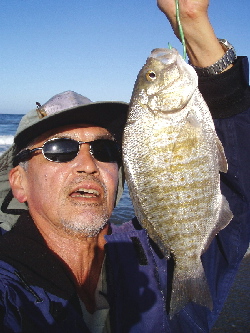 |
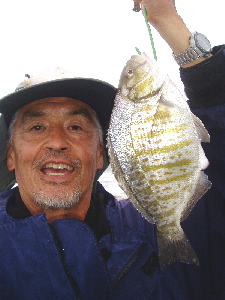 |
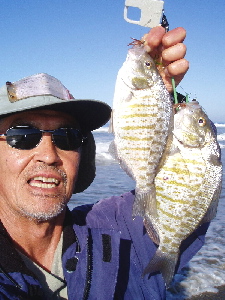 |
Enjoy your skills but try to help sustain the BSP fishery. Numbers of large BSPs and big schools of smaller fish seem down in 2005. Consider catch and release fishing. If you like to eat Barred Surfperch then just remember that each large spawning female that you kill means that there will be 100+ fewer juvenilles each year for its lifetime. Consider your own slot limit - keeping only mid-sized fish (if any). If you practice catch and release, get your fish quickly and minimize their stress in handling and release them quickly.
- Develop Impeccable Line Control. Cast after the largest swell of a swell set hits so that your line has time to sink before the next one hits. You need to be connected to your fly through a straight line without slack to be able to feel a fish take your fly. The late Jim Lazarotti is shown above casting in sync with waves. If you have a side current, cast up current to compensate for drift. If your line gets broadside to water movement, it will be swept away. Keep your rod down and align your rod tip with your line as you retrieve. Focus on retrieving smoothly while tuning for the slightest change in tension. If you increase the length of your retrieve stroke, it will be easier to feel variations from the norm. Start and end the retrieve smoothly. Retrieve speed has to be varied as swells hit. Sometimes, you can stop retrieving because the backwash is keeping the line straight. Other times, you have to strip at full speed to keep you line tight as new waves hit. A fish will occasionally hook itself but it is usually the case that it you won't feel anything without line control. A hot bite could be in progress but without line control you could be wondering if there was any life in the surfzone.
- Develop high-sensitivity strike detection.
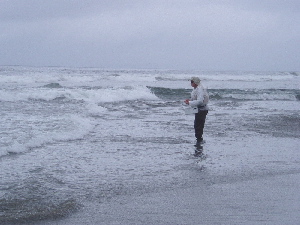 A hit can feel like a subtle tick, bump or wiggle. Sometimes your line just starts to snug up, or weight comes off of it. It can feel like it is dragging through sand. When it does, it really might be dragging through sand because of the actions of fish on the other end. Occasionally, a hit is followed by the heavy throbs of a fish taking your fly. These hits are obvious but big fish hits can be very subtle too. With long casts over foamy flats, you are dealing with so much line stretch and surf hydraulics. You only feel a slow snugging up and it isn't until you strip like crazy that you find that you have a big fish on. The feel really depends on how much line you have out. Closer hits will feel sharper. Hits at 100-ft will just feel like you line is gradually or suddenly snugging up. Hits at the inside edge near shore will usually be hard and obvious but they can be subtle as well depending on the direction that the fish is going. Also, sometimes you line is dragging through the sand at the ledge which buffers any fish actions. Strip and sweep set upon any change in line/fly dynamics. Keep the rod pointed more or less in line with the line/fly direction. To strip set, react against any change in dynamic with your left hand. Timing may prevent this so you may have to sweep set by sweeping your rod with the line locked The late Jim Lazarotti is shown in Zen state retrieving.
A hit can feel like a subtle tick, bump or wiggle. Sometimes your line just starts to snug up, or weight comes off of it. It can feel like it is dragging through sand. When it does, it really might be dragging through sand because of the actions of fish on the other end. Occasionally, a hit is followed by the heavy throbs of a fish taking your fly. These hits are obvious but big fish hits can be very subtle too. With long casts over foamy flats, you are dealing with so much line stretch and surf hydraulics. You only feel a slow snugging up and it isn't until you strip like crazy that you find that you have a big fish on. The feel really depends on how much line you have out. Closer hits will feel sharper. Hits at 100-ft will just feel like you line is gradually or suddenly snugging up. Hits at the inside edge near shore will usually be hard and obvious but they can be subtle as well depending on the direction that the fish is going. Also, sometimes you line is dragging through the sand at the ledge which buffers any fish actions. Strip and sweep set upon any change in line/fly dynamics. Keep the rod pointed more or less in line with the line/fly direction. To strip set, react against any change in dynamic with your left hand. Timing may prevent this so you may have to sweep set by sweeping your rod with the line locked The late Jim Lazarotti is shown in Zen state retrieving.
- Use only small, sticky sharp, small barb, small wire size hooks.
 This is key to getting the numbers up. Hits provides the positive feedback that the water you are casting into holds fish. If you have the ability to feel all of your hits, you get very important information about the fish concentration in this water. If you feel only those that hook themselves, you have a very serious handicap that will limit the number of fish that you catch drastically. Surfperch have relatively small mouths and are feeding with low visibility in water that is in constant motion. Small hooks will make it easier for flies to be inhaled by surfperch and the sticky sharp, small barb, small wire size hooks will improve the ratio of sets to hits. The Tiemco 3761 hooks a great hook for Surfperch. I use it on all of my surfperch flies. I typically use size-6 while fishing is good. Lately, I have down-sized to size-10 (small-profile worm and shrimp) flies to keep the action up by hooking more smaller fish. You can go smaller but size-10 is still heavy enough for bigger fish.
This is key to getting the numbers up. Hits provides the positive feedback that the water you are casting into holds fish. If you have the ability to feel all of your hits, you get very important information about the fish concentration in this water. If you feel only those that hook themselves, you have a very serious handicap that will limit the number of fish that you catch drastically. Surfperch have relatively small mouths and are feeding with low visibility in water that is in constant motion. Small hooks will make it easier for flies to be inhaled by surfperch and the sticky sharp, small barb, small wire size hooks will improve the ratio of sets to hits. The Tiemco 3761 hooks a great hook for Surfperch. I use it on all of my surfperch flies. I typically use size-6 while fishing is good. Lately, I have down-sized to size-10 (small-profile worm and shrimp) flies to keep the action up by hooking more smaller fish. You can go smaller but size-10 is still heavy enough for bigger fish.
- Cast like a machine into high likelihood holding water. The more time you have your fly in front of feeding fish the more fish you are going to catch. If you have found a school, work your flies within their holding zone. Any working outside their holding zone is wasted time. After working through the zone you can rapidly retrieve to cast again.
- Staying with schools once you have found them. In holding water, you can imagine that a school of fish forms a cloud. You can retrieve through the thickest part and be into a lot of fish or you can retrieve through the edges and get only a few. If you have multiple hits during one retrieve (in low visibility water), it is a good indication that you have found a school. In clear water, it could be a fish following. Getting double hookups is also a good indication. When you find a school, conditions do not stay constant. The swell pattern of the moment usually shifts as the different swell sources interact. This causes the water movements that carry feed to shift and the fish shift accordingly. Learning to follow schools is key to getting numbers up. Watch the indications of good holding water as these shifts occur and test by moving one way or the other to keep into fish. If you find one, play it fast and cast again you might get a few fish before they move on.
- Recognizing more varieties of high likelihood water to fish.
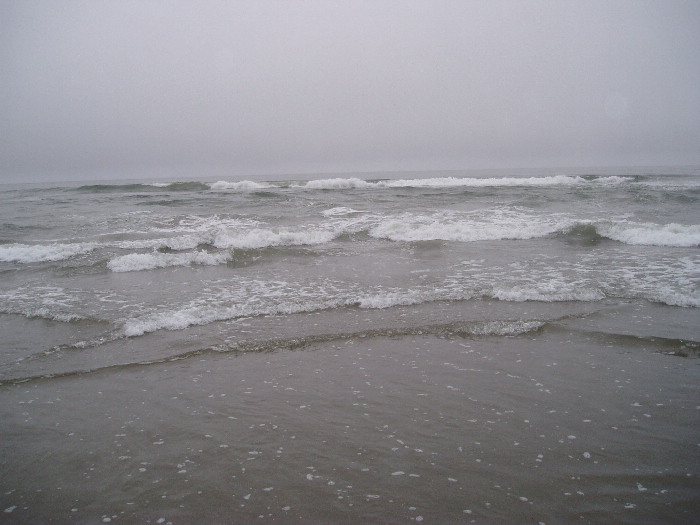 Everytime you get a hit or catch a fish, ask yourself what it is about the water your were fishing makes it good holding water. Everytime you see anybody get a hit or catch a fish, do the same thing. Over time, you will find more and more varieties of high likelihood water to fish. The more likely waters are:
Everytime you get a hit or catch a fish, ask yourself what it is about the water your were fishing makes it good holding water. Everytime you see anybody get a hit or catch a fish, do the same thing. Over time, you will find more and more varieties of high likelihood water to fish. The more likely waters are:
- edges of any deeper area (cuts, holes, troughs)
- flats with bottom structure (washboard, moguls, mini-troughs)
- flats with interacting swell sources (waves from two directions colliding)
- small rips (sand swirls moving out to deeper water)
- Cast further.
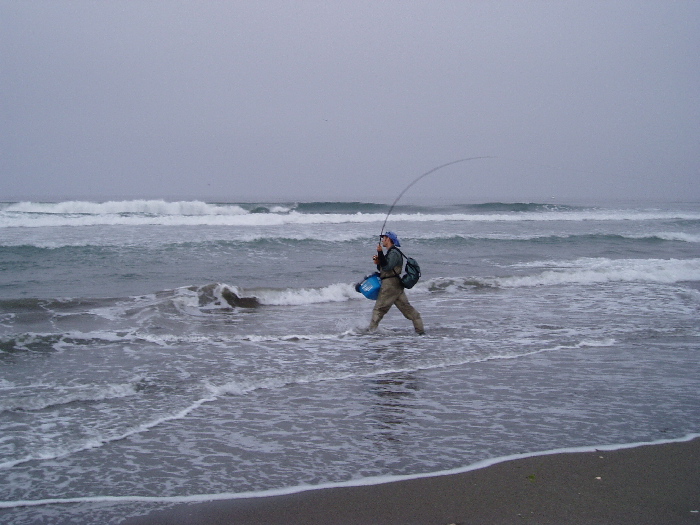 Casting further gives you access to more holding water. You don't have to always cast far but surfperch frequently are holding more than 60-ft out. This is even true with late-spring, summer and fall conditions. I can cast 100-ft on the water if required. I usually limit it to 80 to 90-ft because line control gets difficult. I have experienced times when 100-ft was necessary to get fish on consistently and other times when 100-ft was not enough. The photo shows Craig S putting his weight into loading his spey rod with a huge stripping basket (120 to 150-ft class gear). I use a heavy leadcore shooting head with as light a shooting line that I can handle (usually 0.021-inch). I condition the line with Russell Peak's Line Dressing before every session. I can cast easily to 80-ft even with moderate winds.
Casting further gives you access to more holding water. You don't have to always cast far but surfperch frequently are holding more than 60-ft out. This is even true with late-spring, summer and fall conditions. I can cast 100-ft on the water if required. I usually limit it to 80 to 90-ft because line control gets difficult. I have experienced times when 100-ft was necessary to get fish on consistently and other times when 100-ft was not enough. The photo shows Craig S putting his weight into loading his spey rod with a huge stripping basket (120 to 150-ft class gear). I use a heavy leadcore shooting head with as light a shooting line that I can handle (usually 0.021-inch). I condition the line with Russell Peak's Line Dressing before every session. I can cast easily to 80-ft even with moderate winds.
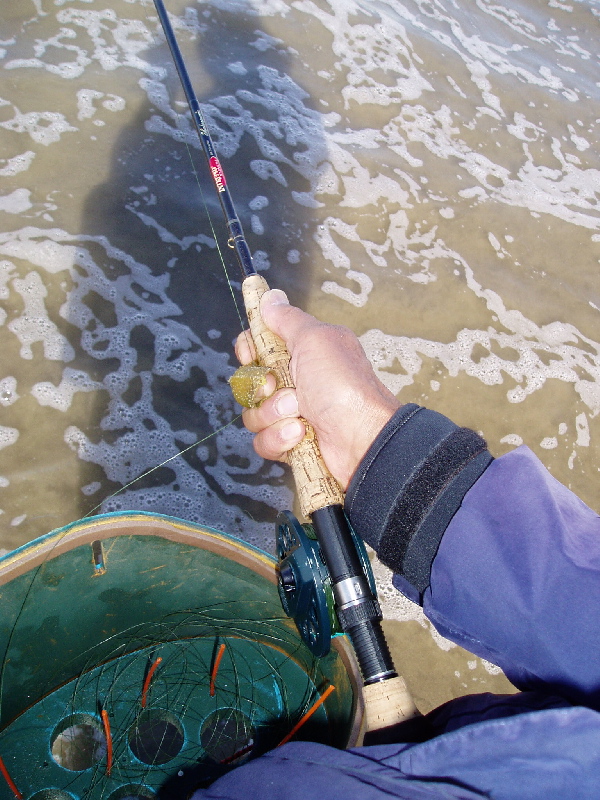
- Slack line control using a stripping basket This minimizes tangles during casting and usually prevents line wrapping around your feet. It maximizes the time your fly is in holding water and allows you to cast much further. My shooting basket has long weed-wacker mono fingers that allows a lot of shooting line to be coiled up without tangling. (See my equipment page for more details.)
- Keep moving if you do not find a concentration; however, there are some areas worth searching. Do not over fish a slow area. If you don't find a school keep moving. If fishing is slow, there are areas that may not produce immediately but are worth searching. These are areas that schools or pods move within. Take time to figure out an area that should have fish even though you have had no hits. Flats and the inside edge of deeper areas fall in this category.
- Frequently, all it takes is one good hole to get the numbers up.
On slow days, I always wonder if all the fish have collected at some magical places that eludes me, and if I search long enough I will find it.
 Sometimes on a slow day, I will drive to the furthest end of my usual fishing range to get into as different conditions as possible. Sometimes, it pays off. I usually keep moving afoot if I do not find good concentrations of fish.
Sometimes on a slow day, I will drive to the furthest end of my usual fishing range to get into as different conditions as possible. Sometimes, it pays off. I usually keep moving afoot if I do not find good concentrations of fish.
- Fish frequently once you discover patterns. Swell patterns and tides usually don't change a lot in a day and if you find great holding water that produces during some tide stage then it has a good chance of repeating the next few days. This is especially true for the larger more persistent structures like classic cuts. Some beaches have similar structure year after year that you can take advantage of.
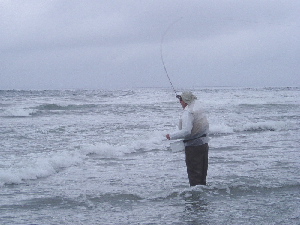
I get mixed feelings about finding a lot of large spawners stacked up in a classic cut. Yes, it is a blast but fishing is too easy! Anyone can get limits of large fish when this happens. Consider the impact of multiple fisherman killing 5 large spawners every day that good conditons hold! It is good that it doesn't happen very often. Nature finds its balance. When the fishery declines, fishing gets harder and less fishermen show up. My ideal is to have fishing that is not easy. You can still get the numbers up if you work on these keys.
Questions or Comments
Contact:
Glenn Yoshimoto
glenn@zenflyfishing.com
Los Gatos, California
 zen fly fishing home
zen fly fishing home
Published: September 24, 2005
This page © Copyright 2005, Glenn Yoshimoto